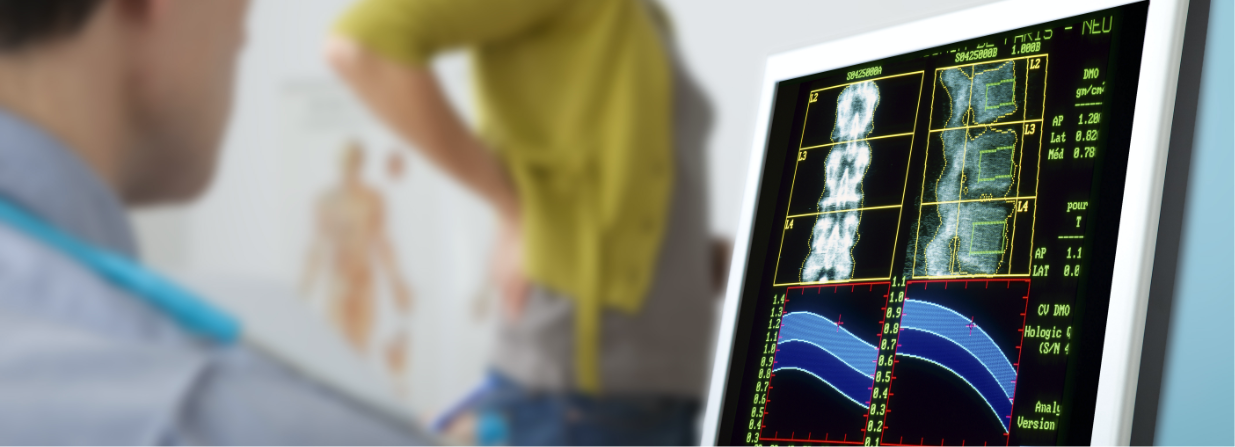Review some of the most commonly asked questions about Degenerative Disc Disease Treatment:
- What is Degenerative Disc Disease?
- What are the Degenerative Disc Disease symptoms?
- Is surgery necessary for Degenerative Disc Disease?
- What are the non-surgical treatments for Degenerative Disc Disease?
What is Degenerative Disc Disease?
Degenerative Disc Disease is a common condition caused by worn-down spinal discs. Wear and tear on the discs is normal over time, and physicians give the degenerative disc disease diagnosis when that degeneration causes pain and other symptoms.
Spinal discs are fluid-filled cushions between your vertebrae. One of their most important functions is to act as shock absorbers for the spine. They also play a role in allowing the spine to stay flexible. When they shrink and lose height, there are a range of associated consequences and conditions. Because they may press on nerves or cause the vertebrae on either side to rub together, Degenerative Disc Disease is also associated with spinal stenosis, spondylolisthesis, and herniated discs.
What are the Degenerative Disc Disease symptoms?
The most common degenerative disc disease symptoms are neck and back pain. Because degenerative disc disease can affect any part of the spine, some of the more specific symptoms are dependent on the exact location of the condition.
Another common attribute of degenerative disc disease is pain that starts and stops for various lengths of time. The pain may last for days, weeks, or months at a time before abating for a period and then resuming. Degenerative disc disease symptoms can also include numbness and tingling, pain that radiates throughout the lower back or into your arms and hands, and pain that increases in intensity with sitting, bending, or lifting. Mild, moderate, and severe pain are all symptomatic of degenerative disc disease.
Is surgery necessary for Degenerative Disc Disease?
Surgery is the right option for many degenerative disc disease patients, though certainly not all. If symptoms of degenerative disc disease are significantly affecting your quality of life, recurrent or progressive over time, or if there is significant weakness or numbness, surgery is often recommended. Consulting closely with your physician will help you determine whether surgery is the best course of treatment to relieve your symptoms. Symptom relief is the major goal of procedures for this condition, since it is not possible to rehydrate (and therefore enlarge) discs after they have started degenerating.
There are various types of procedures that surgeons apply to treat degenerative disc disease symptoms. One option is spinal fusion surgery, which is a procedure that secures two or more bones of the spine together. Spinal fusion is a safe and effective option for certain patients that need surgical intervention to improve stability in the spine. It can take several months or years for the bones to fully fuse together and heal, but patients who undergo spinal fusion often experience a higher quality of life afterwards. For patients that have degenerated discs in their cervical spine, Anterior Cervical Discectomy and Fusion may be the right approach. This procedure involves a spinal fusion component in addition to the removal of the damaged disc from the cervical spine.
Artificial disc replacement is another surgical option that may be appropriate in selected cases. This involves complete removal of the diseased disc and replacement with an engineered implant that mimics the function of the spinal disc.
Another treatment option is spinal decompression surgery, which is designed to relieve pressure on compressed nerves. There are also many subtypes of this procedure, including discectomy, corpectomy, foraminotomy, laminotomy or laminectomy, and osteophyte removal. Osteophytes are bone spurs that also impinge on nerves and cause pain.
Again, consulting with an experienced physician will be the best route to knowing if surgery makes sense in your case. At our comprehensive spine center, we take every patient’s individual risk factors and severity of their symptoms into account before recommending surgery.
What are the non-surgical treatments for degenerative disc disease?
There are also non-surgical treatments that address degenerative disc disease symptoms. For example, working with a licensed physical therapist can be a good approach to lessening pain. Physical therapy will involve a series of exercises and stretches that build strength and relieve pressure in the spine. A physical therapist will be able to tailor their recommendations based on the location of the degenerated discs and what positions feel the most comfortable.
Your physician may also recommend lifestyle changes that can help address your pain. Some patients find that wearing a corset brace or cervical spine collar can help lessen the weight that your spine has to bear. Losing weight may also help reduce pressure on the spine, as may a regular exercise routine focused on core strength.
Overall, many patients are able to manage symptoms with medication, physical therapy, and other mild adjustments to their daily routine. But it’s important to note that if your degenerative disc disease symptoms are detracting from your quality of life, there are safe and effective surgical procedures as well.

